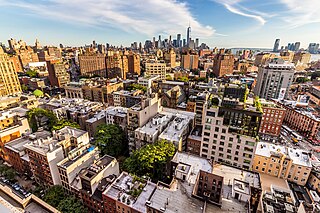
Greenwich Village, or simply the Village, is a neighborhood on the west side of Lower Manhattan in New York City, bounded by 14th Street to the north, Broadway to the east, Houston Street to the south, and the Hudson River to the west. Greenwich Village also contains several subsections, including the West Village west of Seventh Avenue and the Meatpacking District in the northwest corner of Greenwich Village.

NoHo, short for North of Houston Street, is a primarily residential neighborhood in Lower Manhattan in the New York City borough of Manhattan. It is bounded by Mercer Street to the west and the Bowery to the east, and from East 9th Street in the north to East Houston Street in the south.

The Grand Central Hotel, later renamed the Broadway Central Hotel, was a hotel at 673 Broadway, New York City, that was famous as the site of the murder of financier James Fisk in 1872 by Edward S. Stokes.

Mulberry Street is a principal thoroughfare in Lower Manhattan, New York City, United States. It is historically associated with Italian-American culture and history, and in the late 19th and early 20th centuries was the heart of Manhattan's Little Italy.

Ernest Flagg was an American architect in the Beaux-Arts style. He was also an advocate for urban reform and architecture's social responsibility.

The Bayard–Condict Building is a 12-story commercial structure at 65 Bleecker Street in the NoHo neighborhood of Manhattan in New York City. Built between 1897 and 1899 in the Chicago School style, it was the only building in New York City designed by architect Louis Sullivan, who worked on the project alongside Lyndon P. Smith. Located in the NoHo Historic District, the building was designated a New York City landmark in 1975 and has been a National Historic Landmark since 1976.

Bleecker Street is an east–west street in the New York City borough of Manhattan. It is most famous today as a Greenwich Village nightclub district. The street connects a neighborhood today popular for music venues and comedy, but which was once a major center for American bohemia. The street is named after the family name of Anthony Lispenard Bleecker, a banker, the father of Anthony Bleecker, a 19th-century writer, through whose family farm the street ran.
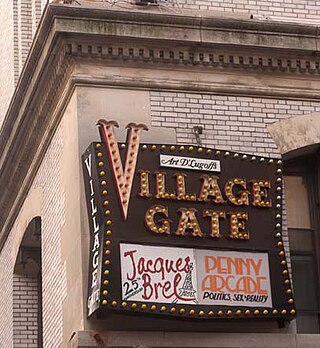
The Village Gate was a nightclub at the corner of Thompson and Bleecker Streets in Greenwich Village, New York. Art D'Lugoff opened the club in 1958, on the ground floor and basement of 160 Bleecker Street. The large 1896 Chicago School structure by architect Ernest Flagg was known at the time as Mills House No. 1 and served as a flophouse for transient men. In its heyday, the Village Gate also included an upper-story performance space, known as the Top of the Gate.

"Common lodging-house" is a Victorian era term for a form of cheap accommodation in which the inhabitants are all lodged together in the same room or rooms, whether for eating or sleeping. The slang terms dosshouse and flophouse designate roughly the equivalent of common lodging-houses. The nearest modern equivalent is a hostel.
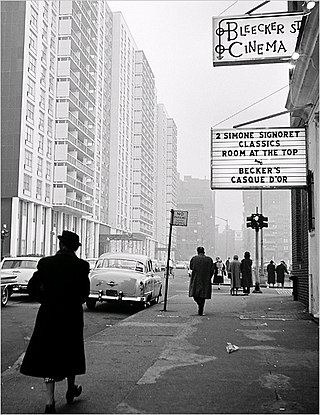
The Bleecker Street Cinema was an art house movie theater located at 144 Bleecker Street in Manhattan, New York City, New York. It became a landmark of Greenwich Village and an influential venue for filmmakers and cinephiles through its screenings of foreign and independent films. It closed in 1990, reopened as a gay adult theater for a short time afterward, then again briefly showed art films until closing for good in 1991.

Washington Square Village (WSV) is an apartment complex in a superblock in the Greenwich Village neighborhood of Manhattan, New York City. WSV was developed by Paul Tishman and Morton S. Wolf. To design the housing complex, the developer selected architects S. J. Kessler and Sons, with Paul Lester Weiner as consultant for site planning and design; landscape architects were Sasaki, Walker & Associates.
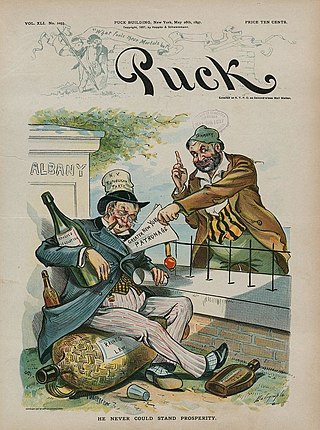
The New York State liquor tax law of 1896, also known as the Raines law, was authored by the New York State Senator John Raines and adopted in the New York State Legislature on March 23, 1896. It took effect on April 1, 1896, was amended in 1917 and repealed in 1923.
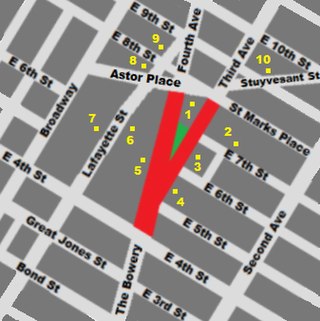
Cooper Square is a junction of streets in Lower Manhattan in New York City located at the confluence of the neighborhoods of Bowery to the south, NoHo to the west and southwest, Greenwich Village to the west and northwest, the East Village to the north and east, and the Lower East Side to the southeast.

Patchin Place is a gated cul-de-sac located off of 10th Street between Greenwich Avenue and the Avenue of the Americas in the Greenwich Village neighborhood of Manhattan, New York City. Its ten 3-story brick row houses, said to have been originally built as housing for the Basque staff of the nearby Brevoort House hotel, have been home to several famous writers, including Theodore Dreiser, E. E. Cummings, John Cowper Powys and Djuna Barnes, making it a stop on Greenwich Village walking tours. Today it is a popular location for psychotherapists' offices.

Walter Boughton Chambers, AIA was a successful New York City architect whose buildings continue to be landmarks in the city’s skyline and whose contributions to architectural education were far-reaching.

Bank Street is a primarily residential street in the West Village part of Greenwich Village in the borough of Manhattan in New York City. It runs for a total length of about 725 metres (2,379 ft) from West Street, crossing Washington Street and Greenwich Street, to Hudson Street and Bleecker Street where it is interrupted by the Bleecker Playground, north of which is Abingdon Square; it then continues to Greenwich Avenue, crossing West 4th Street and Waverly Place. Vehicular traffic runs west-east along this one-way street. As with several other east-west streets in the Far West Village, the three blocks west of Hudson Street are paved with setts.

Mori was a Greenwich Village eating establishment that featured Italian cooking. It became bankrupt during the aftermath of the Great Depression. Its building later housed the Bleecker Street Cinema.

2-10 Horatio Street is a 17-story co-operative apartment building located between Greenwich and Eighth Avenues, on the corner of Greenwich Avenue, across from Jackson Square Park in the Greenwich Village neighborhood of Manhattan, New York City, United States. Built in 1929–31 and designed by Robert T. Lyons, the building is located within the Greenwich Village Historic District, but is not an individual landmark. The building also has the address 123-129 Greenwich Avenue.

Our Lady of Pompeii Church, or more formally, the Shrine Church of Our Lady of Pompeii, is a Catholic parish church located in the South Village neighborhood of Manhattan, New York City, in the United States. The church is staffed by Scalabrini Fathers, while the Our Lady of Pompeii School is staffed by Apostles of the Sacred Heart of Jesus. It is located across from Father Demo Square, which is named for the church's third pastor, Antonio Demo.
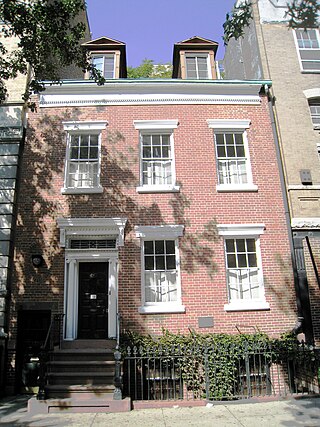
Charles Street is a street in the West Village neighborhood of Manhattan in New York City. It runs east to west from Greenwich Avenue to West Street. The street was named after Charles Christopher Amos, who owned the parcel the street passed through. Amos is also the namesake of Christopher Street, two blocks to the south, and the former Amos Street, which is now West 10th Street. Charles Lane is a one-block alley located between Charles and Perry Streets and Washington and West Streets. From 1866 to 1936, the section of Charles Street between Bleecker Street and West 4th Street was called Van Ness Place after a farm, owned by the Van Ness family, which had occupied the square bounded by Bleecker, West 4th, Charles and Perry Streets until 1865.






















